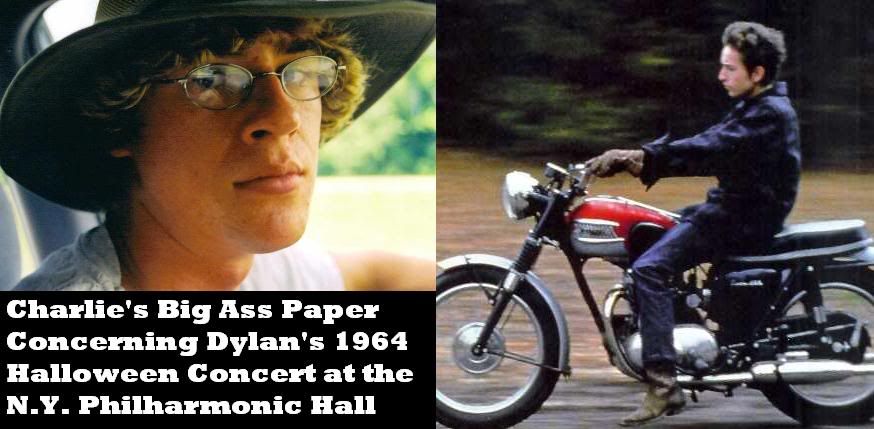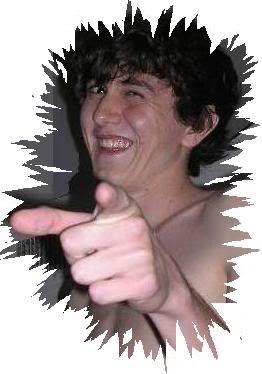
Recently, our good buddy
Charlie F. wrote a big paper on Bob Dylan's 1964
Concert at the New York Philharmonic Hall. Here it is for your reading pleasure:
------------------------------------------------------------------------------------
“And the first one now, /Will later be last, /For the times they are a-changin'”
-
Bob Dylan (from “The Times They Are A-Changin’”)
The Age of Innocence was dead. So to was Kennedy. Triggered by the president’s shocking death, America plunged into a decade-long examination of her fundamental values and mores. The beatnik undercurrents of the 1950s came screaming to the forefront of the national consciousness by the early Sixties, triggering the rise of a counterculture movement that laid challenge to traditional national institutions. By the summer of 1964, a young folk singer from Minnesota, Bob Dylan, had risen to national prominence as the preeminent symbol for the fledgling movement. Dylan exposed the crass absurdities of a “lily-white” America promoted in the wake of World War II. Throughout his career, he used folk ballads, satires, powerful rock numbers, and tender love songs to speak candidly with America’s disillusioned youth. His epoch performance at New York’s Philharmonic Hall on Halloween 1964 engaged a generation of young, politically minded Americans and symbolized the emergence of a new folk culture movement dissatisfied with American society and power politics. The shattering of exuberance, hope and youthful innocence elicited by the Kennedy assassination provides the foundation for Dylan’s prodigious commentary on racial and social injustices, anticommunist idealism, and the rising turbulence in the American psyche.
Dylan’s dramatic performance at the New York Philharmonic on 31 October 1964 intimately portrays the multifarious nature of the social and political dissent spreading among America’s youth. He establishes his dominance over the folk genre from the onset, opening with the seminal protest classic “The Times They Are A-Changin’,” in which he speaks of a “battle outside ragin’” that will “soon shake your windows and rattle your walls.” Dylan warns traditionalists that “the order is rapidly fading” and uses biblical language to assure social outcasts that “the first ones now will later be last.” His message of hope and social revolution is not easily received by the conservative forces which dominated the previous decade, nor readily forgotten by those allied with the Popular Front movement searching for a new Woody Guthrie. The raucous cheers of the audience as Dylan walks on stage, followed by their quiet applause after the first line of “The Times” indicates the tense excitement surrounding this new rebellious hero and the high reverence to which his musical prophesy was held.
Despite his success in the folk genre, Dylan was uncomfortable with the comparisons to Guthrie. When asked to comment on the renowned folk singers influence, Dylan remarked, “Because… Woody Guthrie [was telling his story] much better than I ever could, I decided to stick to my own” (Wilentz, 6). Acknowledging Guthrie’s influence but clearly uncomfortable, Dylan gives deference and attempts to distance himself from the folk legend. His reluctance to fit predetermined categories can clearly be seen in his repertoire on Halloween night. He follows the folk classic “The Times They Are A-Changin’” with a deeply surrealistic work, “Spanish Harlem Incident:”
I been wond'rin' all about meEver since I seen you there.On the cliffs of your wildcat charms I'm riding,I know I'm 'round you but I don't know where (Dylan). Dylan sings of a regal woman posing majestic powers. Standing in stark contrast with the overtly political lead tune, the language of “Spanish Harlem Incident” relies on fantastical visions and idyllic pronouncements. Dylan chronicles his self examination, singing, “I been wond’rin’ all about me.” He uses confusing language to demonstrate his inner conflict; a conflict precipitated by the social forces around him. He has lost all semblance of space as he sings “I know I’m round you but I don’t know where”. Through “Spanish Harlem Incident” Dylan quickly established a unique presence among the concert goers. Part social philosopher, part artistic visionary, he commands the entire attention of his audience and delivers an inspiring and challenging performance. As he transitions from folk to surreal, Dylan highlights the complexities of the new counterculture movement; inspired by beat artists and social injustices alike, it would struggle for a decade against conservative forces calling for unity and conformity.
Although he dabbled in surrealism during his show on Halloween night, Dylan’s performance continued to echo a direct challenge to the traditional bastions of power in American society. Politicians, diplomats, corporations, even the stage announcer were subject to protest. In a foreshadowing of the concerts theme, an employee of the Philharmonic is subjected to boos and mocking cheers from the hostile crowd as he delivers a stern, monotone warning against smoking and photography. To the charged crowd he represents all that Dylan fights against: a drab corporate figurehead forcing morality upon the youthful audience. “With God on Our Side” delivered with Joan Baez in the second set, stands as the ultimate provocation of such authorities. The combination is chilling; Baez appears as a modern Aphrodite, her supernatural voice perfectly complimenting Dylan’s, the humble bard with whom she shares the stage. Hauntingly poetic, the seventh stanza disturbingly portrays the disaster that befalls those who accept without question the decrees of government:
But now we got weapons
Of the chemical dust
If fire them we're forced to
Then fire them we must
One push of the button
And a shot the world wide
And you never ask questions
When God's on your side (Dylan).
Baez’s voice arches over Dylan’s in the middle of each verse, then falls off in regretful tone. They decry the confusion of the times, when the “push of the button” spells doom for the world. Dylan’s lyrics highlight the dangerous absurdities of the fifties and early sixties, when open condemnation of the government was shunned. He masterfully reminds his audience that “…you never ask questions/When God’s on your side,” explicitly denigrating the institutions that force such authoritarian fallacy upon the people, as well as the citizens themselves for accepting these pronouncements.
Throughout the show, Dylan speaks poignantly of the social injustices still prevalent in American society, and the growing turmoil plaguing the American psyche. Dylan, like many other social critics of the time, was dismayed by the barbaric climate of hate he saw simmering throughout the nation. At the Philharmonic, he performed one of his most famous folk songs, "Who Killed Davey Moore," which likens the death of boxer Davey Moore to some sort of Romanesque gladiator brawl in which the audience, ever hungry for violence, drives the competitors to their doom. Dylan describes the atmosphere that night with maniacal diction, speaking of the “gambling man,” the "angry crowd," and the “boxing writer/Pounding print in his old typewriter” as contributors to Moore’s death. He rebukes the idea of a tradition which insensitively claims that “… fist fighting is here to stay/ It’s just the old American Way”. Dylan is troubled by this violent vision of his society, romanticized by many as the “American Way.” In one of his most famous ballads, “Hey Mr. Tambourine Man” Dylan and his audience at the Philharmonic enter a surrealistic world. Beat down by the troubles and complexities of the time, Dylan begs of the Tambourine Man, “Then take me disappearin' through the smoke rings of my mind,/Down the foggy ruins of time, far past the frozen leaves,/The haunted, frightened trees…”. In the songs quiet, almost reminiscent narrative tone, Dylan looks for respite in the rhythms of song and dance. His consciousness, indeed the consciousness of a nation so shattered by the Kennedy assassination has drifted further into despair amongst the civil strife of the previous year. Dylan is tired and beaten: “My weariness amazes me, I'm branded on my feet,/ I have no one to meet.” Blind and lonely, Dylan’s surrealistic vision speaks directly to the tortured youth who feel abandoned by their own society.
The rising racial violence of the Fifties and Sixties provided ample material for Dylan’s scornful exegesis of the events surrounding the death of a black woman, Hattie Carol, at the hands of a young and well connected white man, William Zanzinger. “The Lonesome Death of Hattie Carroll” opens with a sorrowful harmonica as Dylan seems to apologize to the African American community for violence outbreaks across the country. Dylan exposes the inequalities that remain pronounced in American society, idealizing the humble servant Hattie Carroll “Who just cleaned up all the food from the table.” Again, he relies on biblical references to the servants who picked the crumbs from the foot of the table to invoke amongst the audience a sense of injustice out of line with America’s supposed moral righteousness. In the final stanza his lyrics become familiarly satiric, even angry. He opens with a pronouncement: “In the courtroom of honor, the judge pounded his gavel,” seeming to recognize the power of law; but he swiftly follows with a masterful condemnation of America’s two sided justice: “And handed out strongly, for penalty and repentance,/William Zanzinger with a six-month sentence.” Zanzinger predictably recieves a ridiculous sentence, six months for the murder of a gentle servant of God. Dylan employs religously charged language to speak broadly to a citizenry that seemed to ignore such injustice.
Symbolized by the McCarthyism of the early Fifties and the growing American presence in Vietnam in the early Sixties, the anticommunist idealism that has swept America in the years since the Second World War increases Dylan’s disillusionment with a government that fosters such policy and the contemporary mainstream culture responsible for propagandizing the movement. Dylan openly satirizes such ideology in the third tune of the night, “Talkin’ John Birch Paranoid Blues.” This crowd pleaser fictionalizes the plight of a member of the John Birch Society, an organization created in the Fifties to combat communism on the home front. Dylan pokes fun at the contagious hysteria promoted by such organizations: “ I snuck around the house with a huff and a hiss,/ Sayin’ hands up you communist,/ It was the mailman… he punched me out”. Taking such ideology to the extreme, Dylan imagines the condemnation of Betsy Ross: “…they wus red stripes on the American flag! /That ol' Betty Ross…”. Each stanza is followed by appreciative laughter and often applause from the audience, indicating they echo Dylan’s sentiments. A growing number of Americans recognize the hypocritical nature of such organizations: although they claim to promote democratic values, members are purged in communist-like fashion.
In starkly different terms, Dylan’s recondite “A Hard Rains A-Gonna Fall” was written in the dark days of the Cuban Missile Crisis. Dylan recalls the inspiration; it “…is a desperate song. Every line in it is actually the start of a whole song. But when I wrote it, I thought I wouldn’t have enough time alive to write all those songs so I put all I could into this one” (liner notes, The Freewheelin’ Bob Dylan). Dylan’s chaotic visions represent the “peace-through-balance-of-terror” (Nat Hentoff, liner notes, The Freewheelin’ Bob Dylan) ideology of the Cold War governments. His youthful protagonists a “blue-eyed son” and “darling young one” conjure up images of innocent American children corrupted by the dogs of war. The crowd at the Philharmonic sat in rapture as Dylan delivered verse after verse full of wickedly disturbing images: “I saw ten thousand talkers whose tongues were all broken,/I saw guns and sharp swords in the hands of young children;” again in the following stanza: “Heard ten thousand whisperin' and nobody listenin',/Heard one person starve, I heard many people laughin',/Heard the song of a poet who died in the gutter.” Beat poet Alan Ginsberg’s from howl undoubtedly provided inspiration for the phrasing of such verse. Dylan ends his first set just as he began, “A Hard Rains A-Gonna Fall’s” harrowing imagery stands as warning against those hawkish forces pushing America to the brink of nuclear destruction.
Bob Dylan’s epic performance on the evening of 31 October 1964 marked a pivotal moment in the career of the singer and the nature of the counterculture movement. Singing at one of the most conservative venues in the city, the New York Philharmonic, Dylan introduced his repertoire of traditional folk ballads and haunting surrealistic musical journeys to a generation of youth disillusioned by the martyrdom of their President and uncomfortable with the growing disturbances in American society. The Philharmonic demonstrates Dylan’s unparalleled command of the agitprop folk-realism and his beautiful knack for abstract philosophy. His play-list stemmed from the revolutionary ballad, “The Times They Are A-Changin’,” to the Ginsbergesque prophesy, “A Hard Rains A-Gonna Fall.” The Philharmonic Concert stunningly demonstrates the power of music on the youth of the 1960s. No longer content with traditional values, these youth soon initiated a movement unprecedented in American society. Just before the concert, Dylan remarked, “I ain’t scared to step out, man” (New Yorker, 24 Oct 1964). By the end of that fall, neither was a generation.
------------------------------------------------------------------------------------
I apologize for any spelling or grammar mistakes, but there is no way I'm peer-editing this thing. Just deal with.




































